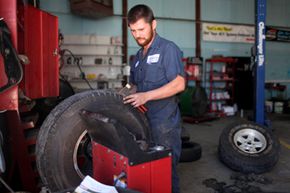It's every car buyer's nightmare -- driving your new baby off the dealer's lot only to discover later on that it's a lemon!
Fortunately, with later-model cars at least, tough competition in the auto industry has ratcheted up quality. From the initial quality of the auto parts used in manufacturing cars, to long-term auto part longevity, car buyers have a lot less to worry about than they once did.
Advertisement
With unbiased reviews, known maintenance issues and car part information easier to come by than it was years ago, the balance of power in auto purchasing has been shifted to consumers.
In this article, we'll look at four car parts in particular -- the ones that put the torque to the tarmac and that keep your coach in contact with terra firma. We're talking, of course, about your tires. When it comes to car part longevity, your tires are a component you definitely want to monitor on a regular basis. That's because their condition has a big impact on your fuel economy, the comfort of your car's ride and its overall safety.
The great thing about tires sold in the United States is how easy it is to know and understand the important specs. Unlike much auto part information, you don't have to hunt far to find the most important information about your car's tires. In fact, the government requires that information to be printed right on their sides! We'll examine what some of those letters and numbers mean in just a bit.
One thing you won't find on the side (also called the sidewall), however, is just how long those tires will last. Just like you don't know exactly how long your car itself will last, predicting the life span of tires is a tricky proposition. But in the following pages, we will look at some ways you can increase the use you get from your tires.
To find out the factors that can either burn rubber or help you to preserve it, roll on through to the next page.
Advertisement






